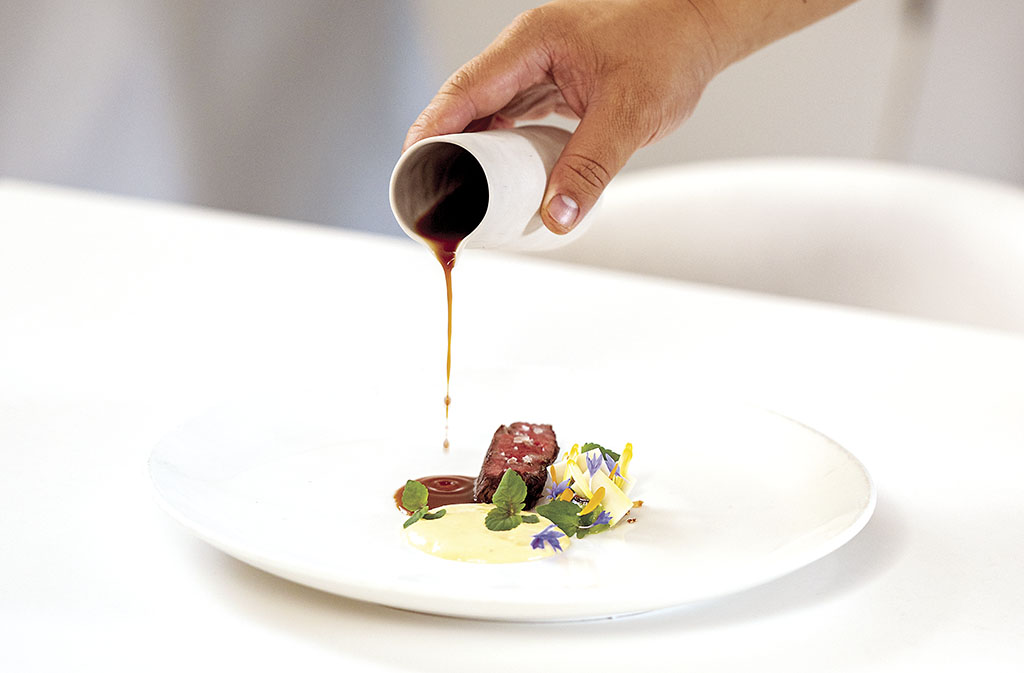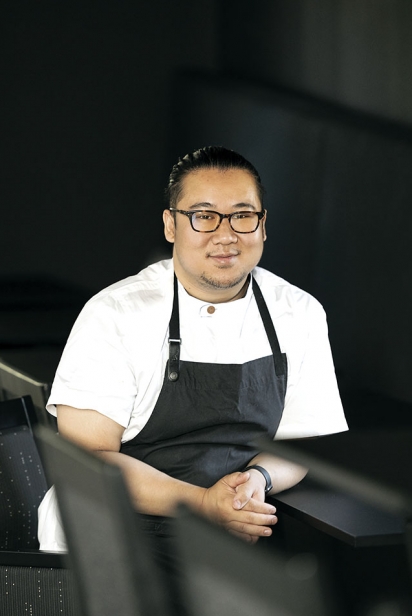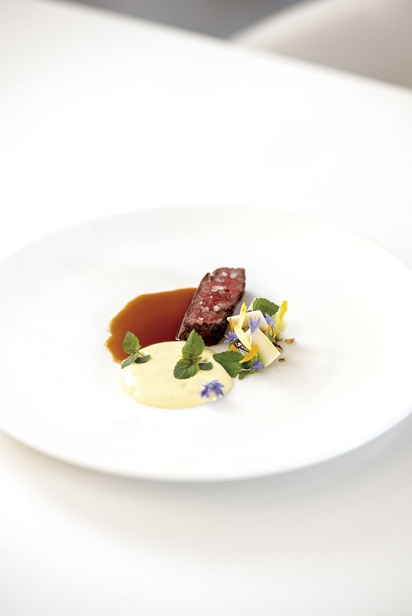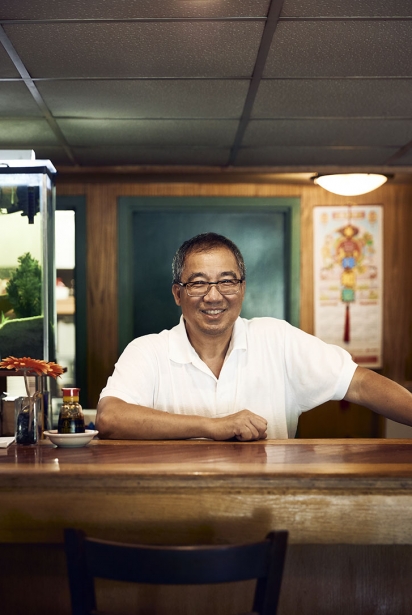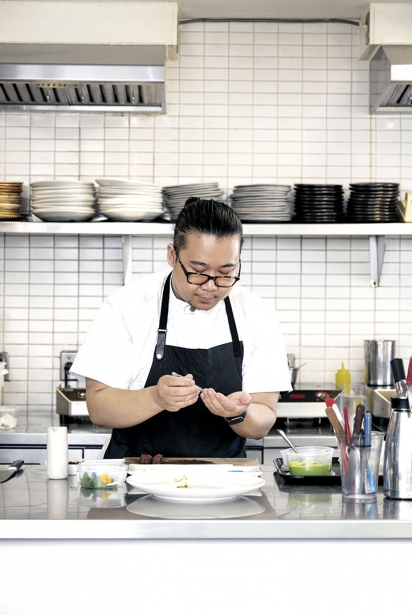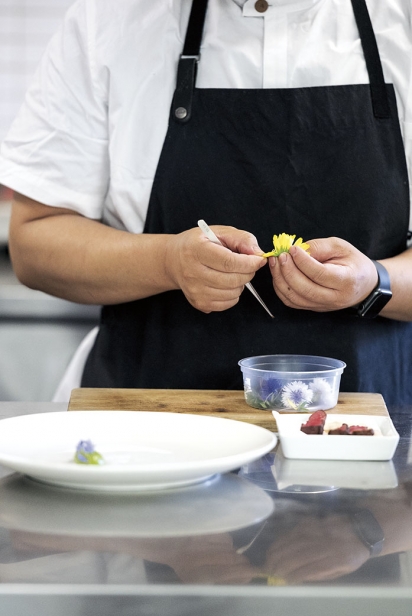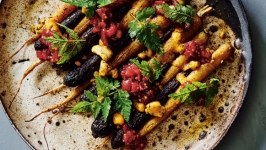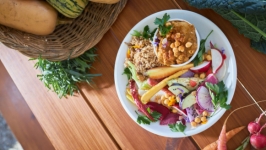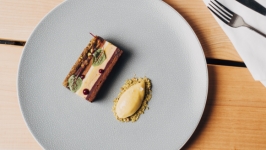When a Restaurant Doubles as a Daycare
Justin Tse is spending his day off making a dish that speaks to his roots. Beef and broccoli is a menu staple his parents still serve at their Chinese-Canadian restaurant in Kingston. Now that Tse is the sous-chef at Atelier, his is, well, different from the one he grew up eating.
He cooked the beef — a chunk of tenderloin — to medium rare in a sous-vide and then gave it a hard-sear in a pan. He had previously marinated it in ginger, garlic and soy sauce and garnished it with Vancouver Island sea salt. He blanched then charred the broccoli and puréed it with lemon juice and ginger and sieved it until silky smooth. Slivers of broccoli stem, pickled in vinegar and yuzu juice, peek out of the purée, alongside bits of soy-caramel brittle made with cashews. If that’s not elevated enough, there’s a “Béarnaise sauce,” made with the fat of roasted Wagyu beef trim, which he sous-vided for 30 minutes, along with shallots, Champagne vinegar, peppercorns, egg yolks, butter and salt and then blended in a Vitamix and transferred to a siphon charged with carbon dioxide. He garnished the whole plate with shiso grown by Backyard Edibles and flowers from Atelier’s garden.
This, he says, is “me on a plate.” A look at his background speaks to that statement.
Restaurant daycare
Growing up, Tse spent a lot of time in his parents’ restaurant, Chinese Palace on Bath Road in Kingston. And over the past six years, he’s spent his summers in a luxury fishing lodge 800 kilometres north of the Arctic Circle. Between summer Arctic stints, he worked in Ottawa and Toronto restaurants and now, he works full-time at Marc Lepine’s celebrated restaurant — Atelier — and his new venture, Thru, which is a six-seat concept restaurant in the back of Atelier. Diners at Thru get 50 — yes 50 — courses over an evening, and each course comes with a QR code to further describe it. It would be hard to find three more starkly different settings.
“We didn’t have a lot of money so the restaurant was our daycare,” Tse says of growing up in the restaurant biz. “When we were old enough and bored enough, we started working. I started by washing dishes and peeling carrots, taking out the garbage. When I could handle a knife, I started helping prep.”
That was his start in the kitchen, but the work was more by necessity than out of any particular love at the time. He actually wanted to become an architect like his uncle.
“I loved design and how particular it was,” he says. “But right before the deadline for college applications, I applied for culinary school. Ultimately, I find all the same things I love about architecture in food.”
Chinese Palace
Chinese Palace caters to Canadian tastes. Salty-sweet spare ribs and heavily breaded chicken balls with sweet red sauce feature prominently on the menu. It’s one of a number of Kingston restaurants Tse’s paternal grandfather opened after the latter's father came to Canada to work on the railroad.
“My dad told me to study hard and never work in a restaurant,” Tse remembers with a laugh. “But here I am and I’m loving it.”
For Tse’s father, Wai Tse, taking over the family business was a natural thing as he had to support four children, including twin girls who are seven years older than Tse and another daughter who’s seven years younger.
Wai Tse’s maternal grandfather Shon Chow was the first to open a restaurant with his brother Kin called China Doll. Then Wai’s father launched House of Peking in 1977.
“We basically grew up in the restaurant,” Wai says. “I started working there in high school and learned the trade there.”
Finally, Wai's father, Shui Ging Tse and his three sons — Wai, John and Yiu — started Chinese Palace. His father passed away, but the three brothers still work in the business, with John taking a behind-the-scenes role. Plenty of other family members have also worked in the restaurants over the years.
For his part, Justin Tse has fond memories of growing up in the restaurant business.
“My sisters and the family will all be there working on Christmas Eve because the restaurant is open,” he says. “I’m very often the delivery guy, but I cook too.”
His mother, Louisa Tse, worked in the restaurant on and off, but left periodically to sell jewelry, work at a bank and finally for an insurance company, where she still works today, while also still putting in time at the restaurant.
Wai — who produced his more traditional Chinese-Canadian version of beef and broccoli for our photo shoot — sees the excitement his son has for his chosen profession and is pleased for him.
“It is a passion,” Wai says. “He’s always trying to do new things. He’s very motivated. He’s trying to incorporate some of the knowledge he has from the family restaurant, too. My mom’s [Justin’s grandmother’s] biggest passion was cooking. We all learned a lot from her. A lot of that background I can see in Justin.”
Given that Tse was in Ottawa this year, for the first summer in six years, his parents made their maiden visit to Atelier in July — for their 38th wedding anniversary.
“My dad will come to Ottawa and have both meals at Yangtze,” Tse says. “My mom is more adventurous.”
True to form, on this most recent trip, the family did have lunch at Yangtze followed by a ravely reviewed meal at Atelier.
“It was a very new experience for me,” Wai says. “I’m more into Asian food, but I do enjoy all types of food around the world. Everything was just beautiful, the presentation, the tastes, the different flavours they put together."
Polar opposites
Arctic Watch is the most northerly lodge on Earth. Located on uninhabited Somerset Island in Nunavut, its summers provide 24 hours of sunlight. Wildlife inhabiting the area includes polar bears, Beluga whales, muskox, seals and narwhals.
The more southerly Arctic Haven, meanwhile, graces the shores of Ennadai Lake and is still above the tree line. It boasts such neighbours as black bears, grizzlies, wolves, caribou, Arctic hares and birds of all kinds. Tse worked at both lodges within his six summers in the North.
“We typically didn’t hunt the wildlife, but the fishing is incredible,” he says.
One avian delicacy on which he did get his hands was ptarmigan, a bird he describes as a cross between duck and quail.
He’d sometimes fish for the evening meals and other times, he’d go fishing with a guest. He’d take additional ingredients, a small table and equipment such as a sous-vide and he’d produce a meal using the fish they’d just caught.
“We’d have a helicopter and fish for the day,” he says. “I’d prepare simple stuff like ceviches.”
He didn’t know what they’d pull out of the water, but it was almost always char at one site and trout at the other.
Another time, he discovered that caribou was his favourite meat to cook — well, second after a very high-end piece of Wagyu beef from Japan.
“Some government people came in one year while we were closing,” he says. “They were doing a caribou survey. Some of the caribou died and they offered them to us. I learned how to skin and butcher them. It was a joy to work with them — even the organs. It was really cool, especially when you think, this animal was alive an hour ago. I’d put caribou and ptarmigan on a tasting menu any day.”
He says the caribou, which he’d never eaten before that day, was “one of the most amazing red meats” he’s ever had.
Urban adventures
Working up North every summer paid well enough that Tse didn’t have to work for the rest of the year. He would usually travel for a couple of months, relax for a couple of months, but eventually he’d become under-stimulated and seek work in Ottawa.
Initially, he worked at Social with Kyrn Stein. A couple of years later, he went to Toronto instead of Ottawa and worked with Oliver and Bonicini, where his mentor, Michael Hay, had gone after leaving The Courtyard Restaurant. He stayed there for the next few summers.
Culinary influences and inspirations
At the age of 18, Tse started working on a paid internship for Michael Hay at the Courtyard Restaurant, coincidentally just after Marc Lepine had left to open Atelier. He remembers having to get a fake ID so he could go out after work.
“Michael was a huge mentor and source of inspiration,” Tse says. “He got me to fall in love with cooking. While I was there, Michael handed me the French Laundry cookbook. I read it and was blown away. From there, I learned about liquid nitrogen and Alinea.”
Tse later secured a table at Alinea, Chicago’s storied molecular gastronomy restaurant, to celebrate his 26th birthday. That launched his interest in molecular gastronomy and soon, when Hay promoted him to pastry chef, he took the chance to do a stage at Moto, another famous, but now closed, Chicago restaurant.
“Standards and the level of detail was incredible,” Tse says. “That started another obsession: Michelin-starred restaurants. It wasn’t really until I ate at Alinea and [its sister restaurant] Next — and they were so creative and modern — that I knew what I really wanted to do.
After the Courtyard, he worked for Marysol Foucault at her second restaurant, Odile, for the year before he was invited to cook up North. He also did a stage at Sat Bains, a two-Michelinstar restaurant in Nottingham — that time with Kyrn Stein.
His Michelin-star obsession has waned from when he was working up North and hitting about six starred restaurants each year. Now he’s not so sure the accolades are as important as he once did.
“I have mixed feelings,” he says. “It’s confusing. Before it was so black and white. You could lose a star for one instance of bad service. But now you can have a [Michelin-starred] food truck — you don’t even need to have a bathroom.”
He’s also annoyed that Michelin hasn’t come to Canada, because he’s certain that Atelier, Pearl Morisette and Alo would also garner stars. Still, he does like to travel and eat. Right now, his sights are on Mirazur, a restaurant on the French Riviera that was just named No. 1 by the World’s Top 50 Restaurants list.
“I got a table on Oct. 5,” he says. “You have to go see that these places to see what’s possible. Each time I visit one, I want to write a whole new menu. You get blown away. It’s not just the food, it’s how they operate.” For inspiration, travelling is his go-to. But it’s not just other restaurants that inspire him. He also likes wandering through museums and art galleries when he travels. “I see dishes in other art forms,” he says.
Lessons learned
In addition to what his travels have taught him, his various jobs have also made him the chef he is today. Up North, he learned to think on his feet.
“If there’s a plane delay, you might not get a shipment; or maybe your eggs come in and they’re all broken,” he says. “It’s another seven days until you get another shipment, and that’s also how long the guests are there.”
You learn safeguards, he says, such as always having egg powder on hand; and doubling the sugar order.
“It taught me the true skill of improvising,” he says. “Now, when a disaster happens, I don’t stress out. It’s a lot easier to go to a grocery store than waiting a week for the next shipment. It’s also made me more conscious of the environment. We had to leave the place pristine, and we had to pay for all of our garbage to be put on a plane and shipped out. I’m less wasteful and use everything, including the whole animal — fur and fat and all of the organs.”
And that brings him full circle to Atelier, where Lepine uses everything he can from a piece of protein or a plant. He also grows his own lush garden in the back of the restaurant.
Being up north also taught Tse survival skills. One year, on a staff camping retreat, they were climbing what they nicknamed Mount Mars because it looked like something out of Star Wars. En route, they discovered a wounded fox who was limping and blind in one eye. It was clear the fox’s mother had abandoned it.
“It was starving, so we rescued it and gave it some food and we carried it around with us for the rest of the trip,” he says. “I was watching the fox while the others were climbing. They were halfway up and I was alone at the bottom with about eight ATVs, and a shotgun and I was holding the fox.”
That’s when he heard his colleagues on their radios talking about a white boulder they spotted.
“Half an hour later, I’m sitting there and I see this ‘white boulder’ walking towards me. It’s not a rock; it’s a pretty big polar bear. We’re trained that if it’s within 20 yards, you fire a shot into the air first, then in the ground around it and if it’s not backing off at that point, you prepare to fire birdshot at it. Worse case scenario, you shoot to kill. Within 20 yards, you can’t outrun a bear.
“I’m holding the fox and loading the shotgun with one hand; the fox can smell the bear and it’s literally peeing and pooping all over me,” he says. “I’m reviewing the shooting protocol. I didn’t end up having to fire a round though, because it started to back away.”
As for fox, they fed it for a week and then left it with a big stock of food in hopes it would survive the winter. In addition to his wilderness survival skills, numerous times he also had to improvise in providing power to the kitchen. When the generator would run out of fuel or broke down, the power would be out. That meant figuring out ways to cook food without using any electrical tools such as blenders, convection ovens and sous-vides. Ultimately, it meant working solely with flames and propane. Other times, the water stopped flowing.
“There are times when the water stops working and you have to get on an ATV and go down the river to figure out why it’s not working,” he says. “Sometimes it’s that the pump was pushed by the current or something has blocked it. Or sometimes it’s more complicated like the times the cliff eroded and buried the pump or took the pump with it. We’ve had to literally McGyver a new water pump until the next shipment would come in. So there were times when you have no electricity and no water and you have to try to fix it at the same time you’re working without it. At the end of the day, you still have to do your regular dayto- day operations and do it in a way that the guests don’t notice any problems.”
He said guests love the waffle machine because every year after they leave the lodge a bear breaks in and smashes the waffle maker around and tries to eat it. “Every year, we find it 30 yards away from the kitchen, covered in bear teeth and claw marks,” he says. “We bring it back in and clean it up. It still works and we still use it. Sometimes we bring it out to show the guests. They love it.”
What’s next?
Tse, who was in the top 10 for Canada in the San Pellegrino Young Chef competition three years ago when he was just 25, and who has competed seven times with various teams in Gold Medal Plates (now Canada’s Great Kitchen Party) competitions, plans to open his own restaurant some day.
“I know that comes with a lot of sacrifices and a lot of reward,” he says. “I’ve missed a lot of important events — birthdays, funerals, weddings. It’s common and unavoidable. You have to figure out how to make it work.”
He and most of his colleagues are obsessed. He finds himself doing restaurant grocery runs on his days off, but he tries to make it fun by going for dim sum with his girlfriend before hitting Chinatown’s stores.
“Balance is something I’m working on and Marc [Lepine] is nothing but supportive of that,” he says. “But the hours don’t get shorter. You really have to love working.”
These days, he reports for work between noon and 1 p.m. and finishes around 11 p.m. five days a week. Those hours are bound to get longer when he’s running the show.


